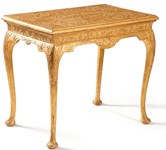The very rare Portrait of an African Soldier in Bonhams’ Islamic & Indian Art sale on March 30 perfectly represents the cosmopolitan atmosphere of the time and place. Executed by an anonymous Persian artist between 1680-90, it is possibly the first portrait of an African figure in Persian art and one of the earliest artistic records of the African community that is still present in the Gulf region.
In the late 17th and early 18th centuries, the final years of the Safavid empire, the Persian city of Isfahan was a nexus of diversity and cultural exchange. Known as nisf-i jahan (half the world), it was a melting pot of traders, ambassadors, scholars, soldiers and slaves from all parts of the known world.
The presence of Africans in Persia dates from as far back as the 6th century, mainly – though not exclusively – through the slave trade.
The 4ft x 2ft 4in (1.22m x 80cm) painting shows a young African man dressed as a soldier and is rich in detail with typically Persian weapons and equipment, and European-influenced uniform and hat. While the sitter is not identified, he is likely to have been a real-life soldier, a musketeer or tofangchi, a division of the Persian army primarily composed of foreign mercenaries.
It could be the earliest known portrait of an African figure in Persian art and one of the earliest artistic records of the African community that is still present in the Gulf region.
On the market for the first time in half a century at Bonhams’ Islamic & Indian Art sale on March 30, it found plenty of admirers and sold at £300,000 plus buyer’s premium (estimate £100,000-150,000).
Oliver White, Bonhams head of Islamic and Indian art, said: “The artist has captured the soldier’s confidence in his status and profession, creating a well-to-do, almost dandyish, image.
“We cannot, of course, know how he arrived in Isfahan. He may have come via the Arab trade from East Africa and the Indian Ocean into the Gulf; he could have been freed as a condition of service in the Persian army, or he may simply have been a free man who had ended up in the city, like so many others.
“What is beyond question, however, is the significance of the work – a rare, perhaps unique portrayal of an African in the Safavid army, and of an African in Persia.”
Some 21 other similar paintings are known showing ‘exotic’ figures in Safavid costume – the so-called Tehran Suite. Some of the subjects come with female companion pieces. They are thought to have been commissioned by visiting Europeans.
It came for sale at Bond Street from ‘an English aristocratic collection, London’. The mother of the vendor had bought it in Jaipur during a visit to the court of Maharajah Man Singh II in the mid 1960s.
















